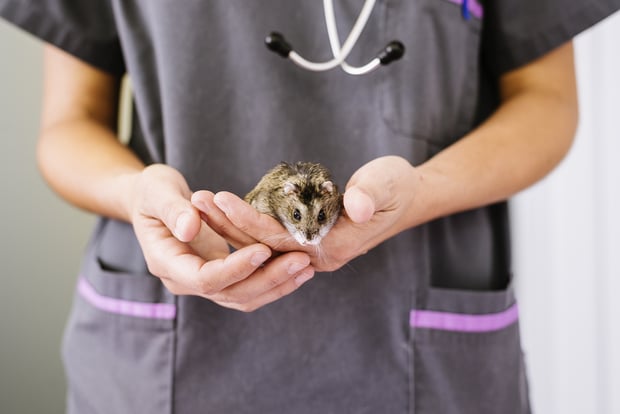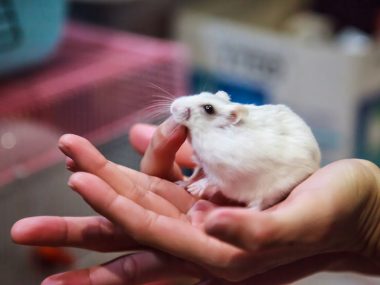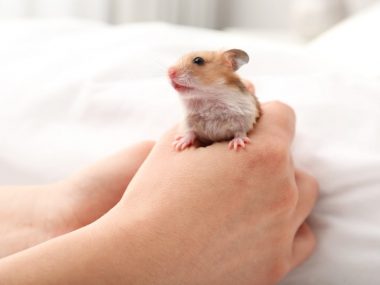The average lifespan of hamsters is approximately 2yrs; however, this does not mean a loving owner is willing to give up at the first sign of their hamster being ill. One of the most common illnesses afflicting hamsters is wet tail. However, what is wet tail, and what does it mean for your hamster?
Wet tail occurs when liquid diarrhea gets stuck to the hamster’s tail and hindquarters. Wet tail in hamsters is relatively common and may be due to various gastrointestinal conditions causing diarrhea. Severe diarrhea is life-threatening, and a veterinarian must treat affected hamsters.
Wet tail is something even experienced hamster owners take seriously, despite the relatively common occurrence of this condition. It is essential that “newbies” to the hamster world learn the ins and out of wet tail in hamsters: how to spot it, treat it and prevent it.
Table of Contents
What Is Wet Tail In Hamsters?
Wet tail occurs in hamsters with severe liquid diarrhea. Diarrhea is defined as a condition affecting defecation in which loose, watery stool is discharged more frequently.
A healthy hamster’s stool (i.e., poop) is typically a small, relatively firm pellet with a dark brown, almost black color. Soft, pale brown stool may indicate the early stages or mild forms of diarrhea, whereas a watery yellow-brown liquid stool is characteristic of severe diarrhea.
Diarrhea in hamsters is divided into acute and chronic conditions and is further classified according to the underlying physiology and cause of diarrhea. The three most common classifications used to define hamster diarrhea include:
- Watery, e.g., osmotic effects of laxative-induced diarrhea seen in hamsters eating too many fruit and vegetables.
- Fatty or malabsorptive diarrhea, e.g., advanced Giardia muris infection in hamsters.
- Inflammatory, e.g., ulcerative colitis as a symptom of Helicobacter spp. in aging hamsters
When evaluating a hamster with wet tail, it is essential to note:
- There may be an overlap between the three diarrhea classifications depending on the diarrhea characteristics and cause.
- Diarrhea, and therefore wet tail, is a symptom of an underlying condition and not a disease in itself.
How Do Hamsters Get Wet Tail Disease?
The most common causes are bacterial, viral, or parasitic gastrointestinal infections causing diarrhea.
The diarrhea-causing gastrointestinal conditions include:
- Proliferative Ileitis
- Tyzzer disease
- Salmonellosis
- Protozoa, .e.g. coccidiosis
- Pinworm
- Tapeworm
- Giardia muris
- Incorrect antibiotic use
- Dietary changes or imbalances
Stress, poor hygiene, and compromised immune systems make many of these conditions worse. Hamsters who have been immunocompromised by poor diets, chronic stress, surgery, pregnancy, or very young or old age are vulnerable to the development of gastrointestinal conditions.
Not only are these hamsters at an increased risk of contracting a viral or bacterial infection, but their prognosis is also more guarded.
The immunocompromised hamsters do not have the resources to “fight off” the disease or withstand the physiological stress of diarrhea; many of these vulnerable hamsters die, even with veterinary intervention.
Is Wet Tail In Hamsters Serious?
Many owners may be tempted to dismiss diarrhea as a non-serious condition; after all, most people have experienced diarrhea and have not perished from the uncomfortable illness.
However, unlike with human adults, diarrhea in hamsters is a severe gastrointestinal condition that can be life-threatening if not treated promptly.
Hamsters with wet tail may die as a consequence of:
- The underlying disease process causing the hamster to have diarrhea.
- Life-threatening dehydration as a result of the hamster’s diarrhea.
In a case of severe diarrhea, a hamster will lose significant amounts of water and electrolytes, resulting in clinical dehydration.
What Are The Symptoms Of Wet Tail Disease In Hamsters?
Symptoms may vary depending on the underlying cause behind the hamster’s diarrhea.
The most apparent symptom of diarrhea in hamsters, regardless of the underlying cause, is a wet tail and rump. Depending on the hamster’s fur color, you may also see yellow-brown smears of dry or wet diarrhea clinging to the hamster’s tail, hindquarter, and belly hairs.
Signs Of Mild Or Early Dehydration
- During the early stages of diarrhea, the hamster may be more thirsty than usual.
- In chronic wet-tail, a hamster may also have significant weight loss. However, weight loss is not always apparent in acute cases of diarrhea.
Signs Of Intermediate Dehydration
- As dehydration progresses, the hamster’s skin will appear to be loose and show tenting, i.e., when the scruff of the hamster is pinched, instead of the skin returning to a normal position, it remains in the “tented” position.
- The hamster will become lethargic and uninterested in eating or interacting with its environment or owner.
- The hamster’s eyes can appear sunken in, and their gums and mucous membranes will feel sticky as they begin to dry out.
- The fur will appear ruffled and rumpled due to loss of piloerector function (i.e., the muscles that pull the hamster’s hair follicles upright and give the hamster its cuddly appearance)
- Decreased urine output, i.e., both volume and frequency of urination, decreases as dehydration progresses.
Signs Of Advanced Dehydration
- The hamster may develop a fever, although this does not occur in all hamsters with wet tail.
- The severely dehydrated hamster becomes confused and uncoordinated.
- The hamster may appear paralyzed, especially in the back legs.
- Urine output stops entirely as the hamster’s kidneys fail.
- The hamster’s heart and pulse rates initially increase (i.e., tachycardia) before slowing down (i.e., bradycardia).
- The hamster’s breathing becomes labored as they struggle to circulate viscous blood to oxygen-starved tissue.
- Eventually, the hamster will become non-responsive, and death with shortly follow.
How Do You Treat Wet Tail Disease In Hamsters?
When treating hamsters with wet tail, the veterinarian’s priority will be addressing the dehydration caused by the hamster’s diarrhea. Depending on the hamster’s condition, the veterinarian will administer fluid therapy and may add electrolytes to the fluid.

Once rehydration therapy has been started, the veterinarian may treat the hamster’s wet tail with antibiotics, dewormers, probiotics, or dietary modifications, depending on the hamster’s underlying medical condition.
The veterinarian will advise the owner to change the hamster’s bedding and thoroughly sterilize all the hamster’s toys, fixed housing, bowls, and cages.
If the hamster is kept in a cage or room with other hamsters, the owner will need to take precautions to protect the other hamsters. The healthy hamsters should be quarantined away from the sick hamster until the risk of infection has disappeared.
How Much Does It Cost To Treat Hamsters With Wet Tail Disease?
The cost of treating a hamster with wet tail will vary based on:
- The area you live in.
- Your veterinarian’s rates, i.e., veterinarians are free to set their rates, and thus, the price will differ between practices.
- The reason for your hamster’s wet tail, e.g., if your hamster’s condition is due to dietary issues, the cost of treatment will be the price of a veterinary consult. In contrast, if a bacterial or viral infection causes the hamster’s diarrhea, the cost will include diagnostic tests and medication.
- The severity of your hamster’s condition, e.g., the worse your hamster’s condition, the more expensive it is to treat as the vet may have to keep your hamster overnight to monitor them.
Most veterinarian practices are willing to tell you the price of the initial consult and give you a quote for treatment once they have completed their initial examination of your hamster.
Can A Hamster Recover From Wet Tail On Its Own?
No, a hamster will not recover from wet tail on its own and should always be seen by a vet; although some cases of wet tail in hamsters are relatively benign (e.g., too much fruit and vegetables in their diet), the majority of wet tail conditions are not.
Failing to treat these conditions or taking a “wait and see” approach to your hamster’s diarrhea could result in irreversible damage that even your veterinarian cannot repair.
Diarrhea in hamsters is always a serious medical condition and should be treated as such.
Can You Prevent Wet Tail Disease In Hamsters?
Prevention of wet tail disease in hamsters is multifaceted and not always foolproof; sometimes, even experienced hamster owners can struggle to prevent a hamster from getting diarrhea.
Five of the best ways to prevent wet tail in hamsters is:
- Avoid buying sickly hamsters
- Manage your new hamster’s stress levels
- Use prophylactic antibiotic drops
- Enforce good hygiene principles
Don’t Buy Sickly Hamsters
When buying a hamster, never buy a hamster who:
- Has got a wet tail and bottom or evidence of fecal matter stuck to the fur of its tail, hindquarters, or belly.
- Is underweight and lethargic.
- Seem uncoordinated and clumsy.
- Whose fur appears dull, matted, and broken.
- Whose eyes seem dull, glazed, and sunken in.
- Who shares a cage with a hamster exhibiting any of the signs mentioned above.
Manage Your Hamster’s Stress Levels
Once you have chosen a healthy hamster, the next step is getting your hamster home and safely installed in its new cage. One of the main risk factors for hamsters developing wet tail is sudden dietary changes and stress.
To avoid over-stressing your new hamster, transport them in a well-ventilated, dark box. Once home, let the hamster familiarize itself with its new cage and ensure there are plenty of hidey-holes to make your hamster feel safe.
Ideally, try to avoid overhandling your hamster during the first 3 to 4 days. A quick, quiet cuddle is alright but don’t go overboard in your enthusiasm for your new pet; once your hamster has settled in, there will be plenty of time for cuddles and playing.
Initially, stick to the same food the pet shop or breeder was feeding your hamster. Gradually change your hamster over to the hamster food you intend to use during a period of 10 to 14 days. You can slowly introduce your hamster to hamster-safe treats after your hamster has switched to their new food.
Use Prophylactic Antibiotics To Prevent Wet Tail In Hamsters
Many exotic veterinarians advise using prophylactic (i.e., preventative) antibiotic drops for young hamsters moving to new homes.
However, if you are unsure whether prophylactic antibiotics are necessary, contact your local veterinarian and ask for advice about the best course of action.
Practice Good Hygiene
Good hygiene is paramount to keeping hamsters healthy. Ideally, their cages should be changed once or twice a week, with a deep clean being performed every couple of weeks. Owners should clean their hamsters’ food bowls and water bowls every day and give them fresh food and water daily.
If your previous hamster was sick or had diarrhea, always thoroughly sterilize everything, the sick hamster could have come in contact with. Always use a new food bag and bedding for a new hamster to avoid cross-contamination of infectious diseases.
Conclusion
Wet tail occurs when liquid diarrhea drenches a hamster’s tail, hindquarters, belly, and rump. Diarrhea is always a serious condition regardless of whether the cause is benign (e.g., dietary changes) or more serious (e.g., proliferative ileitis).
A veterinarian should always examine hamsters with wet tail, and any dehydration should be corrected with appropriate fluid therapy.
While stress cannot cause viral, bacterial, or parasitic infections, it can compromise the hamster’s immune system, leaving them vulnerable to infectious conditions. Effective stress management in young, old or sickly hamsters is a foundational principle in preventing wet tail in hamsters.
References
https://link.springer.com/chapter/10.1007/978-3-642-60473-7_67
https://journals.sagepub.com/doi/full/10.1354/vp.43-1-2
https://www.britannica.com/science/dehydration-physiology
https://www.ncbi.nlm.nih.gov/pmc/articles/PMC3399545/
https://www.msdvetmanual.com/all-other-pets/hamsters/disorders-and-diseases-of-hamsters






